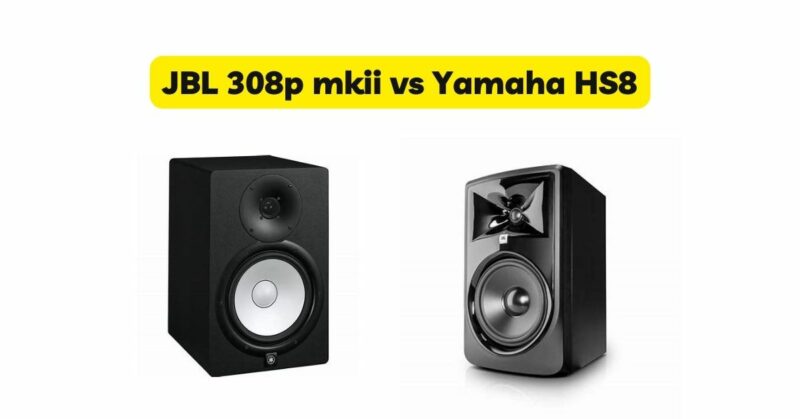Studio monitors play a crucial role in delivering accurate and precise audio reproduction for professional audio production, mixing, and mastering tasks. In this detailed comparison, we will explore two highly regarded studio monitors: the JBL 308p MKII and the Yamaha HS8. By examining their features, sound performance, design, connectivity options, and other essential aspects, we aim to provide a comprehensive analysis to help you make an informed decision based on your specific needs and preferences.
Design and Build Quality
The design and build quality of studio monitors contribute to their overall performance and durability.The JBL 308p MKII features a sleek and modern design with a black enclosure and a distinctive waveguide for its 1-inch soft-dome tweeter. It is equipped with an 8-inch woofer that combines a woven composite cone and a long-throw design for enhanced low-frequency response. The front-firing bass port allows for flexible placement and reduces port turbulence. The monitor’s robust build quality ensures minimal resonance and provides durability.In contrast, the Yamaha HS8 showcases a more understated design with a black enclosure and white driver cones. It incorporates an 8-inch cone woofer and a 1-inch dome tweeter with an advanced magnetic circuit design. The monitor’s enclosure is specifically designed to reduce unwanted resonance and enhance overall accuracy. The HS8’s build quality is exemplary, ensuring stability and longevity.
Sound Performance
The sound performance of studio monitors is a critical factor to consider when assessing their suitability for various applications.The JBL 308p MKII delivers a frequency response range of 45Hz to 20kHz, providing balanced and accurate sound reproduction across the entire frequency spectrum. The combination of the woven composite woofer and the soft-dome tweeter results in a detailed and transparent sound signature. The monitor offers a wide sweet spot, allowing for consistent and accurate listening experiences in various positions within the studio.On the other hand, the Yamaha HS8 provides a frequency response range of 38Hz to 30kHz, offering extended low-frequency response compared to the JBL 308p MKII. The HS8’s cone woofer and dome tweeter deliver a well-balanced sound with precise imaging and excellent clarity. The monitor’s sound signature is known for its accuracy and neutrality, making it suitable for critical listening, mixing, and mastering applications.
Connectivity and Features
Both the JBL 308p MKII and Yamaha HS8 offer a range of connectivity options and additional features to enhance the user experience.The JBL 308p MKII provides balanced XLR and 1/4-inch TRS inputs, ensuring compatibility with a wide range of audio sources. It also includes an adjustable input sensitivity control and boundary EQ settings to optimize the monitor’s response to different room acoustics. Additionally, the monitor features a volume control knob and a high-frequency adjustment switch, allowing users to tailor the sound according to their preferences.Similarly, the Yamaha HS8 offers balanced XLR and 1/4-inch TRS inputs, providing flexibility for connectivity. It also includes room control and high-trim switches to compensate for room acoustics and speaker placement. The monitor’s rear panel features a level control knob and an indicator light for convenient operation.
Price and Application Considerations
When considering the price, the JBL 308p MKII is generally more affordable than the Yamaha HS8. However, it’s important to evaluate the overall value, sound quality, and specific application requirements when making a purchasing decision.Both monitors are suitable for various audio production and monitoring applications. The JBL 308p MKII’s balanced sound reproduction and wide sweet spot make it ideal for home studios, multimedia production, and music listening. It excels in delivering accurate and detailed sound across different genres.The Yamaha HS8, with its extended low-frequency response and precise imaging, is well-suited for critical listening, mixing, and mastering applications. Its neutral sound signature allows for accurate monitoring and ensures that subtle nuances in the audio are captured and reproduced faithfully.
Conclusion
In conclusion, the JBL 308p MKII and Yamaha HS8 are both exceptional studio monitors that offer high-quality sound reproduction, solid build quality, and convenient features. The JBL 308p MKII delivers a balanced sound signature with a wide sweet spot, making it suitable for various applications. The Yamaha HS8, with its extended low-frequency response and precise imaging, excels in critical listening and audio production tasks.Consider your budget, specific application requirements, and desired sound characteristics when choosing between these two monitors. Whether you prioritize affordability, a balanced sound signature, or extended low-frequency response, both the JBL 308p MKII and Yamaha HS8 will provide reliable and accurate monitoring for your audio production needs.

